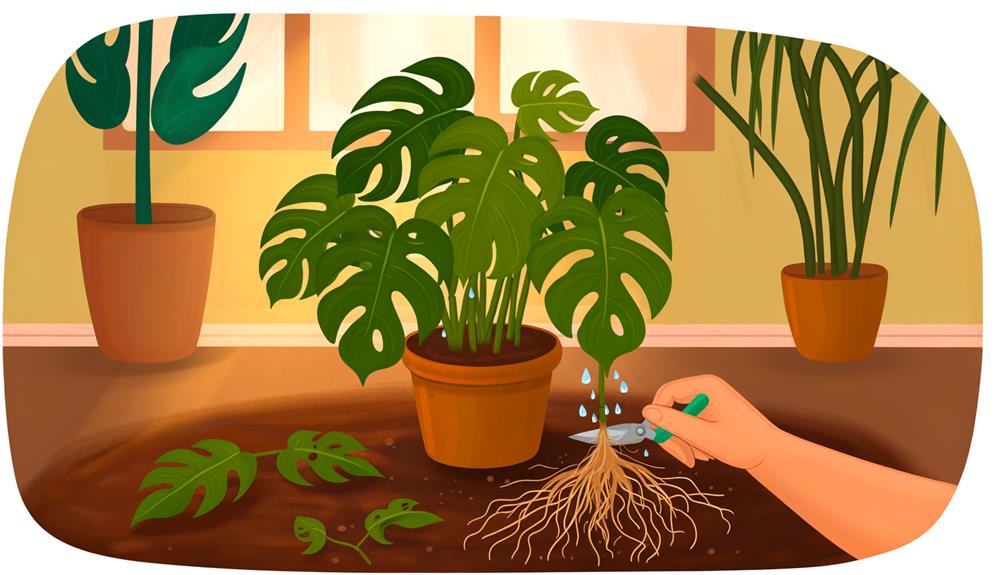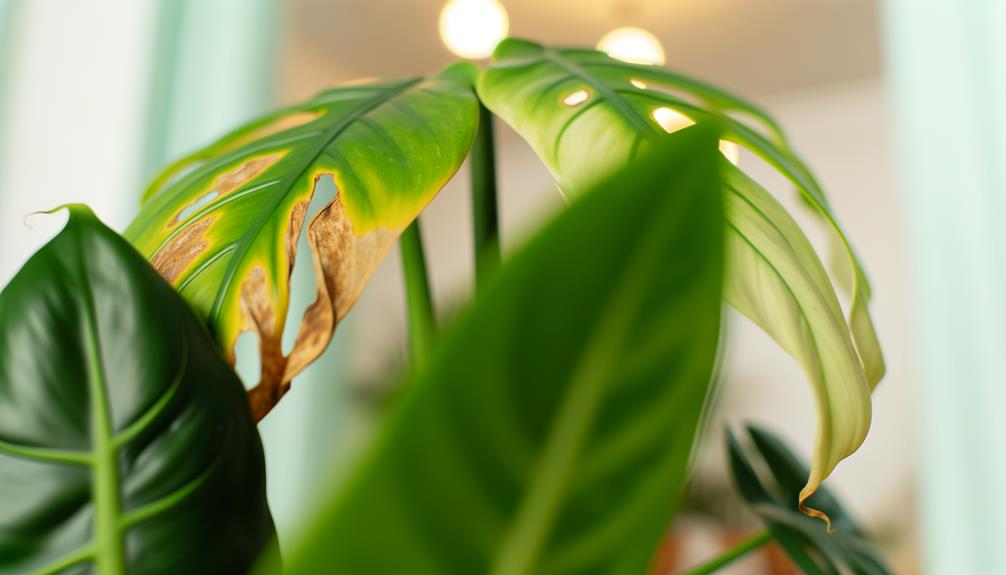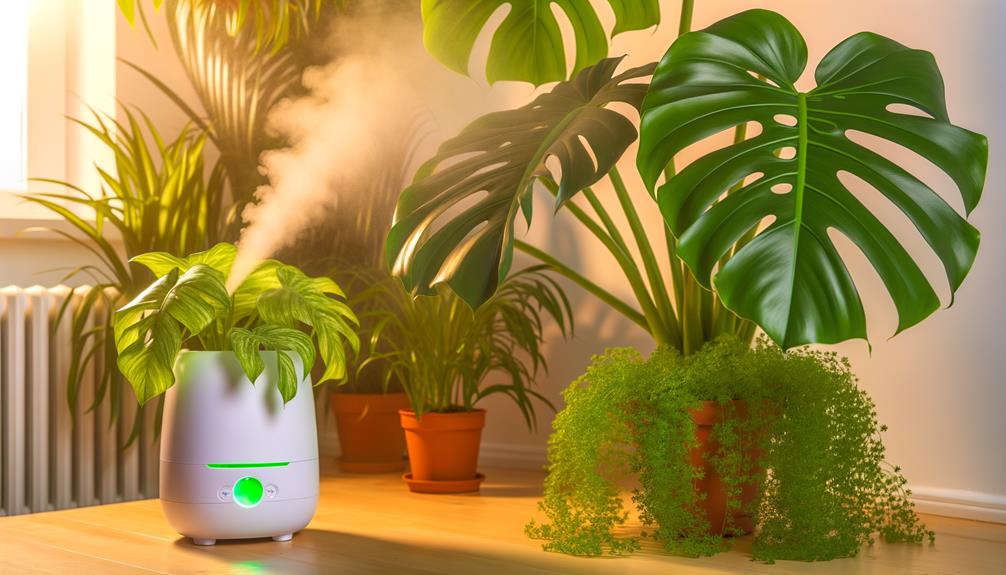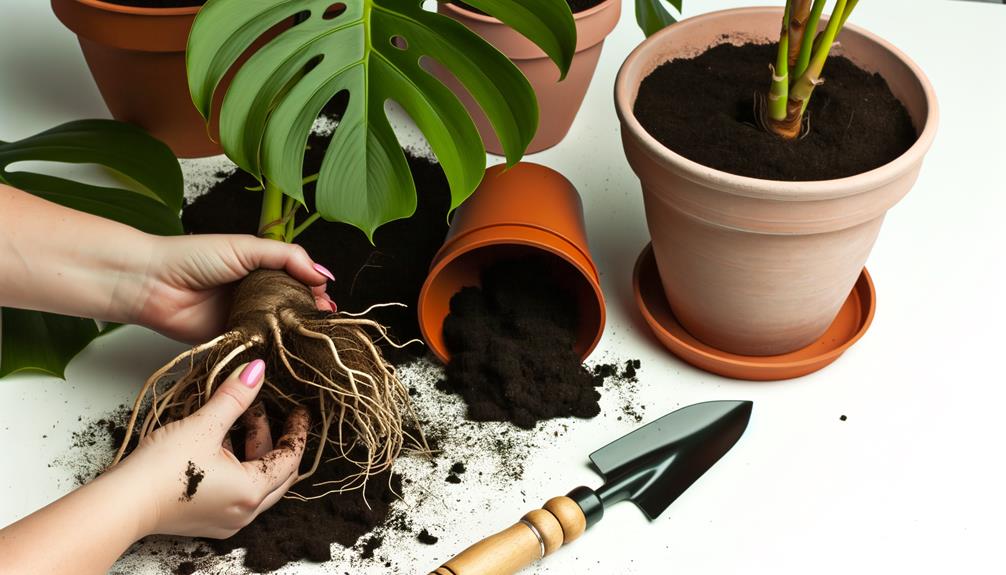How to Revive Monstera Adansonii? Expert Advice!
To revive your Monstera Adansonii, first identify common issues like yellowing leaves from overwatering or dry foliage from underwatering. Confirm it’s in bright, indirect light to avoid leaf burn or leggy growth.
Water when the top inch of soil is dry using filtered water. Use a well-draining soil mix with peat moss, orchid bark, and perlite.
Maintain high humidity (60-80%) and mist leaves regularly. Prune yellow or damaged leaves with sterilized tools to promote bushier growth.
Inspect for pests and apply insecticidal soap if necessary. Repot with a slightly larger pot and fresh soil to stimulate root health.
Continuing forward will deepen your understanding.

Key Takeaways
- Check for proper watering; ensure the top inch of soil is dry before watering again to prevent root rot.
- Provide bright, indirect light by placing the plant near an east or north-facing window with sheer curtains.
- Maintain 60-80% humidity using a humidifier or regular misting to mimic the plant’s natural environment.
- Inspect for pests regularly; use insecticidal soap or systemic insecticides if necessary to manage infestations.
- Prune dead or yellow leaves and stems to promote healthy new growth and improve overall plant health.
Identify Common Issues

To successfully revive your Monstera Adansonii, you must first identify common issues such as improper watering, inadequate lighting, and pest infestations. Begin by examining the soil’s moisture content. Overwatering often leads to root rot, characterized by yellowing leaves and mushy roots.
Conversely, underwatering causes wilted, dry foliage. Next, inspect the plant for signs of pests like spider mites, aphids, or scale insects. These invaders can cause leaf discoloration, deformation, and stunted growth. Detailed observation of the leaves will reveal telltale signs such as webbing, sticky residues, or tiny moving dots.
Addressing these problems promptly ensures your Monstera Adansonii can recover. Detecting and correcting these common issues is essential before proceeding to more specific care adjustments.
Check Light Conditions
After addressing potential water and pest issues, make sure your Monstera Adansonii receives the proper light conditions for best growth. This plant thrives in bright, indirect light.
Direct sunlight can scorch its leaves, while too little light can hinder photosynthesis, leading to leggy growth and pale foliage. Position your plant near an east or north-facing window, or use sheer curtains to diffuse the light.
| Light Condition | Effect on Plant | Recommendation |
|---|---|---|
| Direct Sunlight | Leaf burn, browning | Avoid placing in direct sun |
| Low Light | Leggy growth, pale leaves | Increase light exposure |
| Bright, Indirect Light | Optimal growth, vibrant foliage | Ideal placement near filtered light |
Monitoring and adjusting light conditions will promote healthier, more vigorous growth.
Watering Practices

To sustain your Monstera Adansonii’s health, you must comprehend proper watering frequency. Water the plant when the top inch of soil feels dry. Be vigilant for symptoms like yellowing leaves, which indicate excess moisture.
Recognize signs of overwatering. Use filtered or distilled water to prevent mineral buildup and support the plant’s prime growth.
Proper Watering Frequency
Consistently watering your Monstera Adansonii is crucial to maintaining its health, avoiding both underwatering and overwatering.
To achieve the best hydration, adopt a systematic approach: water when the top 1-2 inches of soil feel dry to the touch. Use a moisture meter for accuracy.
During the growing season (spring and summer), you might need to water every 7-10 days. In the dormant season (fall and winter), extend intervals to 10-14 days.
Always use room-temperature water to prevent shock. Make sure the pot has drainage holes to prevent waterlogging, which can lead to root rot.
Signs of Overwatering
Overwatering your Monstera Adansonii often manifests through symptoms like yellowing leaves, mushy stems, and a pervasive musty odor. These indicators suggest root rot, a critical condition resulting from excessive moisture.
To identify overwatering, examine the following:
- Leaf Yellowing: Chlorosis occurs when roots can’t oxygenate, leading to nutrient deficiencies.
- Mushy Stems: Stems become soft and waterlogged, indicating cellular breakdown.
- Musty Odor: A damp, moldy smell signals fungal growth due to prolonged soil saturation.
Optimal Water Quality
Addressing overwatering issues involves not only adjusting frequency but also promoting the best water quality, as the type of water you use can greatly impact your Monstera Adansonii’s health.
Tap water often contains chlorine and fluoride, which can cause leaf browning and stunt growth. Instead, consider using filtered or distilled water to avoid these harmful additives. Rainwater is another excellent option, providing natural minerals beneficial to plant health.
| Water Type | Benefits |
|---|---|
| Tap Water | Readily available but may contain chlorine/fluoride |
| Filtered Water | Removes harmful chemicals, better for plant health |
| Rainwater | Natural minerals, promotes robust growth |
Regularly monitor your plant’s response to water quality adjustments to promote ideal hydration without detrimental effects. This precision can revive your Monstera Adansonii, restoring its vibrant foliage.
Soil and Drainage
Proper soil composition and effective drainage are essential for the health and vigor of Monstera Adansonii. You’ll need to make sure the medium is well-aerated and retains adequate moisture without becoming waterlogged. A high-quality potting mix tailored for aroids typically works best.
Here’s a precise breakdown:
- Soil Mixture: Combine peat moss, orchid bark, and perlite in a 2:1:1 ratio. This blend offers ideal aeration and moisture retention.
- Drainage: Use pots with multiple drainage holes. This prevents root rot by allowing excess water to escape efficiently.
- Layering: Add a layer of coarse gravel or small rocks at the bottom of the pot. This improves drainage and reduces the risk of water accumulation around the roots.
Following these guidelines will provide your Monstera Adansonii with a strong growing environment.
Humidity Levels

To maintain your Monstera Adansonii thrives, it’s equally important to sustain appropriate humidity levels, as this plant originates from tropical rainforests. Aim for a humidity range of 60-80% to mimic its natural habitat.
Utilize a hygrometer to monitor ambient humidity accurately. If levels are low, employ a humidifier or place a water-filled tray near the plant. Grouping plants together can also create a microenvironment with higher humidity.
Mist the leaves regularly, but avoid waterlogging the soil. Lack of adequate humidity can cause leaf browning and stunted growth. Conversely, overly high humidity can lead to fungal issues.
Balance is key maintain consistent humidity to promote vigorous growth and prevent stress-related ailments in your Monstera Adansonii.
Fertilization Needs
To revive your Monstera Adansonii, you need to prioritize its fertilization needs. Use a balanced, water-soluble fertilizer to guarantee nutrient availability and support vigorous growth.
Adhering to an ideal feeding schedule, such as bi-monthly during the growing season, will optimize its health and essentiality.
Optimal Fertilizer Types
When selecting the best fertilizer for Monstera Adansonii, you should prioritize a balanced, water-soluble formula high in nitrogen to support its vigorous leaf growth.
A 20-20-20 NPK ratio is effective, providing equal parts nitrogen, phosphorus, and potassium, essential for overall plant health. To guarantee nutrient absorption and prevent root burn, always dilute the fertilizer to half its recommended strength.
Here are three top fertilizer types for Monstera Adansonii:
- Liquid Fertilizer: Easily absorbed and evenly distributed when mixed with water, promoting rapid uptake.
- Slow-Release Granules: Provide a steady supply of nutrients over an extended period, reducing the frequency of application.
- Organic Compost Tea: Enhances soil microbiome and offers a natural nutrient boost without chemical additives.
These options will help your Monstera thrive.
Ideal Feeding Schedule
Understanding your Monstera Adansonii’s ideal feeding schedule guarantees it receives nutrients at the best times for robust growth and vibrant foliage. During its active growing season, typically spring and summer, feed your plant every two weeks using a balanced, water-soluble fertilizer diluted to half strength. This prevents nutrient overload and root burn.
In fall and winter, reduce feeding to once a month as the plant’s growth slows. Make sure the soil remains moist, but not soggy, to facilitate nutrient uptake. Regularly monitor the plant for signs of nutrient deficiency, such as yellowing leaves or stunted growth, and adjust the feeding schedule accordingly.
Consistency in fertilization practices will support sustained health and aesthetic appeal in your Monstera Adansonii.
Pruning Techniques

Proper pruning techniques promote the thriving of your Monstera Adansonii by fostering healthy growth and preventing disease. Start by using sterilized, sharp pruning shears to make precise cuts, reducing the risk of infection.
Focus on removing yellowing or damaged leaves, which redirects the plant’s energy to healthier parts. Trim back overgrown stems to promote bushier growth and improve airflow.
Follow these steps:
- Identify Target Areas: Select leaves and stems that are yellow, damaged, or excessively long.
- Make Precise Cuts: Cut just above a leaf node to stimulate new growth.
- Dispose Debris Appropriately: Remove pruned material to prevent pests and diseases.
Understanding these techniques guarantees your Monstera Adansonii remains lush and vibrant.
Pest Control
Maintaining a healthy Monstera Adansonii also involves vigilant pest control to prevent infestations that can compromise the plant’s well-being.
Begin by regularly inspecting leaves and stems for common pests like spider mites, aphids, and mealybugs. Use a magnifying glass to detect these tiny intruders.
If you spot pests, isolate the plant immediately to avoid cross-contamination. Employ insecticidal soap or neem oil as a first line of defense, applying it thoroughly to all leaf surfaces.
For severe infestations, consider using a systemic insecticide designed for indoor plants. Always monitor the plant post-treatment for any adverse reactions.
Consistency in pest control will guarantee your Monstera Adansonii remains robust and free from damaging infestations.
Repotting Tips

Repotting your Monstera Adansonii is essential for promoting healthy root growth and preventing soil compaction, ensuring ideal nutrient absorption. Choose a pot that’s 1-2 inches larger in diameter to provide sufficient space for root expansion. Select a well-draining soil mix, rich in organic matter, to enhance aeration and moisture retention.
Follow these steps for best results:
- Remove the Plant Carefully: Gently loosen the root ball and inspect for any root rot. Trim any damaged roots with sterilized scissors.
- Prepare the New Pot: Add a layer of fresh soil at the bottom to support the root structure.
- Position and Fill: Place the plant in the center, fill around it with soil, and water thoroughly to settle the roots.
Conclusion
Reviving your Monstera adansonii requires pinpointing issues, optimizing light, adjusting watering, ensuring proper soil and drainage, maintaining humidity, providing appropriate fertilization, employing strategic pruning, and vigilant pest control.
Repotting when necessary rounds out your care regimen. By addressing these elements, you’ll transform a struggling plant into a thriving specimen.
Each step interlocks like pieces of a puzzle, creating a lush, vibrant Monstera that flourishes in your indoor jungle.
Your meticulous care will yield a verdant masterpiece.






